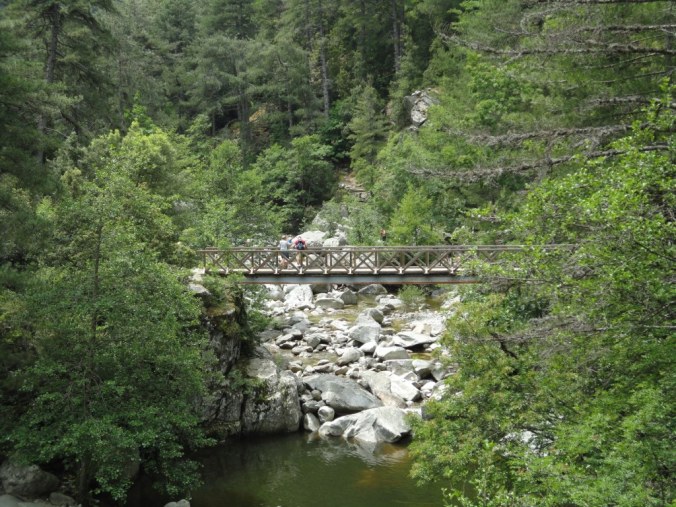
Here’s part 2 of my post about aspects of Corsica that I find inspiring as a writer. Some of them appear in my novels The House at Zaronza and The Corsican Widow, but all of them are things I want to keep experiencing. In writing this post, I have realised that 10 is far too few. So I’ll just have to keep going.
The little train
Corsica’s narrow gauge railway runs from Ajaccio on the west coast to Bastia on the north east coast, with a branch line off to L’Ile Rousse and Calvi. It’s one of the most stunning rail journeys in Europe, cutting through chestnut forests, winding along shelves cut into the rock face and rattling across bridges high over river gorges.
The OH and I took the train (la micheline, as Corsicans affectionately call it) when we went backpacking in Corsica a few years ago. We trundled along, the train scaling the slopes like a faithful donkey, stopping only for livestock on the line. A fantastic way to see the interior of the island. In The House at Zaronza, Maria takes the train from Bastia to Corte on her quest to find her lost love after World War I.
The micheline carriages have now been replaced by rather less romantic, but more comfortable, modern rolling stock.
Walk along the River Tavignanu

In my previous post, I described the town of Corte, one of our favourite places on Corsica. It’s at the confluence of two rivers, the Restonica and the Tavignanu, both running through steep gorges.
A favourite walk is to take the ancient mule track that runs high above the Tavignanu. It’s about 2½ hours to a wooden bridge, where you can paddle in the rock pools and picnic beside them.
You are accompanied by the scent of the maquis, the aromatic vegetation of the hillsides, the sound of the river rushing far below and the cries of birds of prey as they wheel overhead. But take a hat: there is little shade.
Vin de Myrte
An apéritif we love is vin de myrte, myrtle berry wine. This is made with berries picked from the maquis and is a popular drink in Corsica. The best I have tasted is that made by Antoinette Hiver, whose chambres d’hôtes in Saint-Pietro-di-Venaco we stayed at during our backpacking holiday. I couldn’t resist the temptation to mention the drink several times in The House at Zaronza.
The Corsicans also make a fiery eau de vie de myrte. This is not for the faint-hearted and it’s too strong for me. A restaurateur once served us complimentary glasses of it. Not wishing to offend him by not drinking it, we tipped it into the water jug when no one was looking.
Corsican cheeses
For some people, these are an acquired taste, since they are generally pretty pungent. We love them. They are normally made of goat’s or ewe’s milk, since cows are a relatively recent introduction to the island. Many restaurants offer a plate of Corsican cheeses as well as sweet desserts. Invariably, they are served with fig preserve, which complements the flavour of the cheeses.
Corsicans also make a soft cheese called brocciù (pronounced brotch). This is used in omelettes or in pasta dishes, much as the Italians use ricotta.
Chestnuts

Sticking with the food theme, Corsica is covered in parts with dense chestnut forests. They were planted in the 15th century by the Genoese, who possessed the island at that time. The area north east of Corte is called the Castagniccia after the word for chestnut, castagna.
Chestnut flour was once a staple, used for making bread and a kind of polenta. Nowadays, cakes and desserts made with chestnuts are popular restaurant dishes but chestnut cultivation is in decline and the wild pigs mostly eat the nuts. Nonetheless, an annual chestnut fair takes place at Bocognano.
Antoinette Hiver grinds her own chestnut flour with this mini-mill. She makes delicious chestnut biscuits and beignets, which she serves at dinner.

More Corsican gems to follow…
You might also like:
Ten Inspiring Things About Corsica: Part 1
Why Corsica Should be a Happy Hunting Ground for Authors
A Corsican Christmas in Times Past
Copyright © Vanessa Couchman 2015. All rights reserved.




Please Vanessa, do carry on with your Corsican posts! This is wonderful. You are very lucky to have visited this beautiful place. Thank you for sharing some of your memories and photos!
LikeLike
Thank you, Marie. I have realised that holding myself to 10 things is too difficult, and I kept adding things to the list that ought to be there. So watch this space!
LikeLike